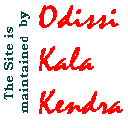|
|
|
 |
Odissi - the Classical Dance Form of Orissa |
|||
|
Odissi
is considered to be one of the oldest surviving dance
forms based on archaeological evidence. The traditional
dance form of Orissa, it owes its origin to the temple
dances of the devadasis (temple dancers). Possibly, the
oldest classical dance form in the country, Odissi has
been mentioned in inscriptions, depicted on scultures, in
temples like the Brahmeswara and the dancing hall of the
Sun Temple at Konark. In the 1950s, the entire dance form
was revitalised, thanks to the Abhinaya Chandrika and
sculpted dance poses found in temples. Odissi as we know it today is the result of a long process of reconstruction from various dance traditions of Orissa, for instance the Maharis, the Goti puas and the Bhandanritya traditions. Maharis are the counterparts of the Devadasis of the South. Goti puas are men who dressed as female dancers and danced like the Maharis. These artistes are not allowed to dance in temples after the age of 18. Kelucharan Mohapatra, an erstwhile Goti Pua, is the greatest exponent and guru of this ancient dance form. While the form is curvaceous, concentrating on the tribhang or the division of the body into three parts, head, bust and torso; the mudras and the expressions are similar to those of Bharatnatyam. Odissi performances are replete with lores of the eighth incarnation of Vishnu, Lord Krishna. It is a soft, lyrical classical dance which depicts the ambience of Orissa and the philosophy of its most popular deity, Lord Jagannath. Odissi is
based on the popular devotion to Lord Krishna and the
verses of the Sanskrit play Geet Govinda are used to
depict the love and devotion to God. The Odissi dancers
use their head, bust and torso in soft flowing movements
to express specific moods and emotions. |
|||